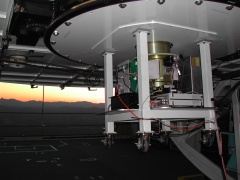| Detector: | 2048 x 2048 pix, HgCdTe Hawaii-2 |
| Pixel scale: | 0.1500 arcsec/pix
(optical layout) |
| Field-of-view: | 5.12 x 5.12 arcmin^2 |
| Electronics gain: | 4.0 e-/DN |
| Read-noise: | 31 e- |
| Full well: | ~190,000 e-, or 48,000 DN |
| Linearity: | Linear to 40,000 DN
(linear to better than 0.1%) |
| Dark current: | 16 e-/s/pix |
| Bias drifts: | The bias changes by
400 DN over 20 sec, thus darks must be taken for every exposure time <20 sec. |
| Filters: |
Y (plot, data),
J (plot, data),
H (plot, data),
and a dark positions D1. |
| Detected electrons: | For 15th mag star (Vega-relative) |
| Y-band: 26,000 e-/s |
| J-band: 33,000 e-/s |
| H-band: 37,000 e-/s |
| Sky background: | Y-band: 650 e-/s/pix = 14.9 mag/arcsec^2 |
| J-band: 470 e-/s/pix = 15.5 mag/arcsec^2 |
| H-band: 2600 e-/s/pix = 13.7 mag/arcsec^2 |
| Exposure time... | for sky to reach 20,000 DN (half the linear regime): |
| Y-band: 90 seconds |
| J -band: 120 seconds |
| H-band: 20 seconds |
| Distortion: | Very small (predicted 0.01% center-to-corner). |
| Cross-talk: | None between quadrants; very little in channels within a quadrant. |
| Flat-fielding: | Sky flats give ~2% accuracy across chip, excluding high dark regions. |
| Known problem: | Channel 4.5 suffers from RMS=19 DN bias variations. |
| Cosmetics: | High dark-current region in upper corners. The "scratch" and spot" cosmetics mask out well. |
| Readout: | 32 channels; 8 channels per quadrants. |
| Readout time: | 0.7 sec per readout; 5 sec total overhead per exposure including telescope dither. |
| Exposure times: | Must be integer seconds >= 1 sec. |

